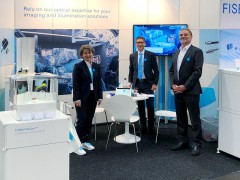
David N Payne:fibre laser is a strong tool
source:Laser Manufacture News
keywords: David N Payne fibre laser
Time:2017-07-17

Introduction
Sir David Neil Payne is a British professor of photonics who is director of the Optoelectronics Research Centre at the University of Southampton. He has made several contributions in areas of optical fibre communications over the last fifty years and his work has affected telecommunications and laser technology. Payne’s work spans diverse areas of photonics, from telecommunications and optical sensors to nanophotonics and optical materials, including the introduction of the first optical fibre drawing tower in a university.
1. First of all I want to know how do you feel about the conference at Han’s Laser (Glabal Laser Intelligent Manufacturing Conference)
I've enjoyed the conference. It's not often you get a chance to meet all these key companies in the industry, mixed with some high academic people from the key Universities in China. It's very exciting. I enjoy it.
2. Could you please talk about your experience to be engaged in fiber lasers?
The fiber laser works started in my university in Southampton in England in 1985. Before that time we had been one of the key laboratory in the world developing telecom fiber. And that became mature into to mass production in1980s, so we wanted to find something else to do. We were the only university in the world that had fiber fabrication equipment. We had a wonderful time. We invented the idea of special fibers. And it ended up in current monitors in polarization maintaining for the optical fiber driver scope, metal containing for polarizers. And then we put some rare earth in. Because rare earth were known to be laser materials but always in crystals before short laser system. And we discovered that if we put the rare earth at very low level, and then pumped it from the end, which is unusual for laser, that we could make lasers that were about ten meters long with very high efficiency. This was in 1985. We immediately started to put all of the rare earth series in. Every single one of the rare earth comes from originally done in Southampton, for all the lasers, fiber lasers we made today. But they were still at a miliwatt. Nobody was very interesting in a maximum of one watt. That was history of fiber laser started.
We always believed that they would be high power. But we had to wait for the diode lasers to be developed and become cheap. Because they were not available, so we were a little bit before our time. And so when they became available, we've got a phone call from DARPA, the US defense research agency. They said how much power could we get from the fiber laser. I was thinking very quickly because I didn’t really know. I said “a kilowatt”. They didn’t believe me. He said “it’s impossible”. I said “I’ll give you one kilowatt but it's only a matter of money”. He thought for a while and he said, “I have money. How much money do you want for one kilowatt?” I said “five million dollars”. And he gave me five million dollars. Within eighteen months, we did one kilowatt fiber laser. That's the history.
3. IPG is the dominant company in fiber lasers. But now we can see SPI and Rofin, etc., starting to challenge the position of IPG. Do you think the industrial pattern will change in the future?
Yes. It’s big shift going on. This is classic signs of an exciting industry beginning to consolidate. As acquisitions and mergers going on. In fact pretty much companies that had fiber fabrication capability or fiber laser capability had been bought up now. All are big players. IPG has done a wonderful job in bringing that to market. I know and respect Valentin Gapontsev who is the founder of the company. And he and I used to know each other pretty well. May be these companies are doing a very good job but I think the Chinese companies particular Han’s Laser will challenge them. It is becoming a global game. It's playing out in China because China is a major manufacturing market. But remember there are America and Europe may be conquering each of these territories. Maybe it will become territorial.
4. Before 2007 actually there was no local-produced commercial fiber lasers in China. But now the local companies are developing very fast. How do you know about Chinese local fiber laser manufacturers?
There's a shakeout going on in the market. And I think that will happen in China. They won’t all survive. The big companies like Han’s Laser – a very professional 20-year old company with global reach and fantastic engineering -- will survive. But as for some of the smaller players in China, there is only room, I would say, for maximum of two or three companies. Maybe there are 30 plus at the moment. So we will see that may happen in the next five years.
5. Fiber lasers are very popular in China and they replaced CO2 lasers in just three years. What do you think of the reasons?
Fiber lasers are better. Efficiency is very important. As we go into green manufacturing, we hope manufacturing needs to use a minimum amount of electrical power. And fiber lasers’ wall-plug efficienct can be 60%, while CO2 lasers are much lower. That’s is one reason.
The other one is that fiber laser has its all solid state. It's monolithic. You turn it on and it just lasts -- no adjustments, no tweaking, no service contract. CO2 lasers are not like that. Cost of ownership is cheaper. Finally it's a matter of wavelength. Ten microns is good for something but one micron is better for other things. I sometimes say it's a little bit like a surgeon. He has a set of tools. He picks up each tool for each job to do. The laser market is a bit like that. You have excimer lasers. CO2 lasers still have their use and will continue with that. But the size of the market will shrink to their specialists. I believe the workhorse will be fiber laser in the future.
6. Fiber lasers achieved the rapid development in recent years. What is your opinion on the future development? Do you think the growing speed will continue in such a way in the following years?
I would say the fiber laser probably has another five to ten years of rapid growth. But like all technologies, it will saturate. My guess is five to ten years. One should also remember, when you said it’s rapid development, actually it was invented in 1985, so that's thirty years ago. It’s interesting how long it takes to get to marketing volume. Thirty years.
- RoboSense is to Produce the First Chinese Multi-beam LiDAR
- China is to Accelerate the Development of Laser Hardening Application
- Han’s Laser Buys Canadian Fiber Specialist CorActive
- SPI Lasers continues it expansion in China, appointing a dedicated Sales Director
- Laser Coating Removal Robot for Aircraft
 FISBA exhibits Customized Solutions for Minimally Invasive Medical Endoscopic Devices at COMPAMED in
FISBA exhibits Customized Solutions for Minimally Invasive Medical Endoscopic Devices at COMPAMED in New Active Alignment System for the Coupling of Photonic Structures to Fiber Arrays
New Active Alignment System for the Coupling of Photonic Structures to Fiber Arrays A new industrial compression module by Amplitude
A new industrial compression module by Amplitude Menhir Photonics Introduces the MENHIR-1550 The Industry's First Turnkey Femtosecond Laser of
Menhir Photonics Introduces the MENHIR-1550 The Industry's First Turnkey Femtosecond Laser of Shenzhen DNE Laser introduced new generation D-FAST cutting machine (12000 W)
more>>
Shenzhen DNE Laser introduced new generation D-FAST cutting machine (12000 W)
more>>
